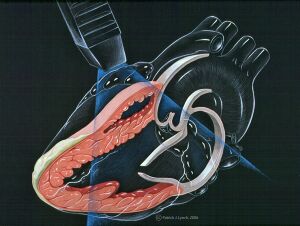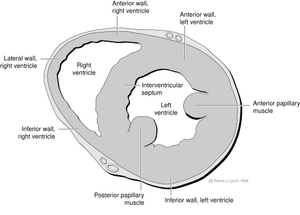ECHO course: Difference between revisions
(some minor changes, feel free to edit mercilessly) |
|||
| Line 2: | Line 2: | ||
=Standard Imaging Planes= | =Standard Imaging Planes= | ||
Imaging of the heart by means of ultrasound is limited by thoracic anatomy. | Imaging of the heart by means of ultrasound is limited by thoracic anatomy. Ultrasound waveforms do not propogate well through air and because of this imaging of the heart is limited to several so-called 'acoustic windows'. These windows are left parasternal, apical, subcostal, suprasternal and right parasternal. Because of the properties of ultrasound, intrathoracic fluid (for instance pleural or pericardial effusion) makes imaging easier but more intrathoracic air (COPD) makes imaging more difficult. | ||
==Parasternal Imaging Planes== | ==Parasternal Imaging Planes== | ||
The left parasternal imaging planes are found by placing the transducer in the third or fourth intercostal space on the left of the sternum. There are four | The left parasternal imaging planes are found by placing the transducer in the third or fourth intercostal space on the left of the sternum. Some instances, such as large hyperplastic lungs in patients with chronic obstructive pulmonary disorder (COPD), may force the sonographer to image the heart from a lower position on the chest wall. There are four parasternal imaging planes: | ||
*parasternal long axis (PSLAX) | *parasternal long axis (PSLAX) | ||
* | -right ventricular inflow view (RVIT) | ||
*parasternal short axis planes (PSAX) | |||
-apical level (PSAX-Apical) | |||
-papillary level (PSAX-LV) | |||
-mitral valve level (PSAX-MV) | |||
-aortic valve level (PSAX-AO) | |||
===Left parasternal long axis=== | ===Left parasternal long axis=== | ||
[[Image:echo_heart_parasternal_long_axis.jpg|thumb|Image showing the left parasternal long axis transection (PSLAX) of the heart by the ultrasound waves]] | [[Image:echo_heart_parasternal_long_axis.jpg|thumb|Image showing the left parasternal long axis transection (PSLAX) of the heart by the ultrasound waves]] | ||
{{IncludeFlash | {{IncludeFlash | ||
|flash_string=<flash>file=PSLAX.swf|quality=best|align=center|width=300|height=200</flash> | |flash_string=<flash>file=PSLAX.swf|quality=best|align=center|width=300|height=200</flash> | ||
|Description=A parasternal long axis | |Description=A parasternal long axis | ||
|file_name=PSLAX | |file_name=PSLAX | ||
}} | }} | ||
| Line 22: | Line 27: | ||
=Apical Imaging Planes= | =Apical Imaging Planes= | ||
There are | There are four apical imaging planes. these are made by placing the transducer on the ictus cordis and thus getting a four chamber view. By rotating the transducer counter clockwise, the two and three chaber views respectively are seen. | ||
*Apical four chamber view | *Apical four chamber view | ||
*Apical five chamber view | |||
*Apical three chamber view | *Apical three chamber view | ||
*Apical two chamber view | *Apical two chamber view | ||
Revision as of 03:50, 5 February 2009
Content is incomplete and may be incorrect. |
Standard Imaging Planes
Imaging of the heart by means of ultrasound is limited by thoracic anatomy. Ultrasound waveforms do not propogate well through air and because of this imaging of the heart is limited to several so-called 'acoustic windows'. These windows are left parasternal, apical, subcostal, suprasternal and right parasternal. Because of the properties of ultrasound, intrathoracic fluid (for instance pleural or pericardial effusion) makes imaging easier but more intrathoracic air (COPD) makes imaging more difficult.
Parasternal Imaging Planes
The left parasternal imaging planes are found by placing the transducer in the third or fourth intercostal space on the left of the sternum. Some instances, such as large hyperplastic lungs in patients with chronic obstructive pulmonary disorder (COPD), may force the sonographer to image the heart from a lower position on the chest wall. There are four parasternal imaging planes:
- parasternal long axis (PSLAX)
-right ventricular inflow view (RVIT)
- parasternal short axis planes (PSAX)
-apical level (PSAX-Apical)
-papillary level (PSAX-LV)
-mitral valve level (PSAX-MV)
-aortic valve level (PSAX-AO)
Left parasternal long axis
| <flash>file=PSLAX.swf |
| A parasternal long axis |
Left parasternal short axis
Apical Imaging Planes
There are four apical imaging planes. these are made by placing the transducer on the ictus cordis and thus getting a four chamber view. By rotating the transducer counter clockwise, the two and three chaber views respectively are seen.
- Apical four chamber view
- Apical five chamber view
- Apical three chamber view
- Apical two chamber view

